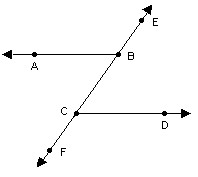Use the properties of parallel lines to solve the problem.In the figure, 

 . Identify all pairs of congruent angles.
. Identify all pairs of congruent angles.
A. ?ABC and ?FCD, ?ABE and ?BCD
B. ?ABE and ?ABC, ?FCD and ?BCD
C. ?ABE and ?FCD, ?ABC and ?BCD
D. ?ABE and ?FCD
Answer: C
You might also like to view...
You want a linearization that will replace the function over an interval that includes the point x0. To make your subsequent work as simple as possible, you want to center the linearization not at x0 but at a nearby integer x = a at which the function and its derivative are easy to evaluate. What linearization do you use?f(x) =  , x0 = 8.9
, x0 = 8.9
A.  +
+  x
x
B.  +
+  x
x
C.  +
+  x
x
D.  -
-  x
x
Subtract. -
- 
A. - 
B. 
C. 
D. 
Estimate the answer by using front end rounding.
A. 150 B. 200 C. 250 D. 225
Restrict the domain of the function f so that the function is one-to-one and has an inverse function. Then find the inverse function f-1. State the domains and ranges of f and f-1. ? f(x) = (x - 5)2 ?
A.
?
The domain of f and the range of f-1 are all real numbers x such that x ? 5.
The domain of f-1 and the range of f are all real numbers x such that x ? 0.
B.

?
The domain of f and the range of f-1 are all real numbers x such that x ? 0.
The domain of f-1 and the range of f are all real numbers x such that x ? -5.
C.

?
The domain of f and the range of f-1 are all real numbers x such that x ? 5.
The domain of f-1 and the range of f are all real numbers x such that x ? 0.
D.

?
The domain of f and the range of f-1 are all real numbers x such that x ? 0.
The domain off-1 and the range offare all real numbersxsuch thatx ? 5.
E.

?
The domain of f and the range of f-1 are all real numbers x such that x ? -5.
The domain of f-1 and the range of f are all real numbers x such that x ? 0.
